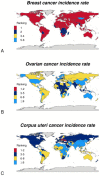Risk-Reducing Breast and Gynecological Surgery for BRCA Mutation Carriers: A Narrative Review
- PMID: 36835955
- PMCID: PMC9967164
- DOI: 10.3390/jcm12041422
Risk-Reducing Breast and Gynecological Surgery for BRCA Mutation Carriers: A Narrative Review
Abstract
This narrative review aims to clarify the role of breast and gynecological risk-reduction surgery in BRCA mutation carriers. We examine the indications, contraindications, complications, technical aspects, timing, economic impact, ethical issues, and prognostic benefits of the most common prophylactic surgical options from the perspectives of a breast surgeon and a gynecologist. A comprehensive literature review was conducted using the PubMed/Medline, Scopus, and EMBASE databases. The databases were explored from their inceptions to August 2022. Three independent reviewers screened the items and selected those most relevant to this review's scope. BRCA1/2 mutation carriers are significantly more likely to develop breast, ovarian, and serous endometrial cancer. Because of the Angelina effect, there has been a significant increase in bilateral risk-reducing mastectomy (BRRM) since 2013. BRRM and risk-reducing salpingo-oophorectomy (RRSO) significantly reduce the risk of developing breast and ovarian cancer. RRSO has significant side effects, including an impact on fertility and early menopause (i.e., vasomotor symptoms, cardiovascular disease, osteoporosis, cognitive impairment, and sexual dysfunction). Hormonal therapy can help with these symptoms. Because of the lower risk of developing breast cancer in the residual mammary gland tissue after BRRM, estrogen-only treatments have an advantage over an estrogen/progesterone combined treatment. Risk-reducing hysterectomy allows for estrogen-only treatments and lowers the risk of endometrial cancer. Although prophylactic surgery reduces the cancer risk, it has disadvantages associated with early menopause. A multidisciplinary team must carefully inform the woman who chooses this path of the broad spectrum of implications, from cancer risk reduction to hormonal therapies.
Keywords: BRCA; breast cancer; endometrial cancer; gene mutation carrier; ovarian cancer; pathogenetic gene mutations; risk-reducing surgery.
Conflict of interest statement
The authors declare no conflict of interest.
Figures



References
-
- Li G., Guo X., Tang L., Chen M., Luo X., Peng L., Xu X., Wang S., Xiao Z., Yi W., et al. Analysis of BRCA1/2 mutation spectrum and prevalence in unselected Chinese breast cancer patients by next-generation sequencing. J. Cancer Res. Clin. Oncol. 2017;143:2011–2024. doi: 10.1007/s00432-017-2465-8. - DOI - PMC - PubMed
Publication types
LinkOut - more resources
Full Text Sources
Miscellaneous

